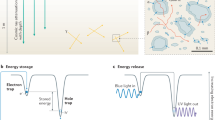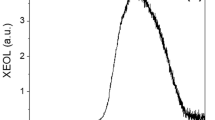Abstract
Recent work has identified IR stimulated luminescence signals at elevated temperature from both potassium- and sodium-rich feldspars that have much lower anomalous fading rates than the conventional signal measured using IR stimulation at 50°C. This paper examines the stability of these signals for potassium-rich sedimentary feldspars. We show that the natural post-IR IRSL (pIRIR) signal from a 3.6 Ma old sample is in apparent saturation on a laboratory generated dose response curve, i.e. it does not show detectable fading in nature although a low fading rate is observed on laboratory time scales. We show that the pIRIR signal has a greater thermal stability than the IRSL signal and that the trend in increasing thermal stability is mirrored by a decreasing fading rate. We also investigate the effect of preheat temperature and IR stimulation power on the decay shape and conclude that the data can be explained in terms of either a single- or multiple-trap model. We present evidence that may suggest that at least part of pIRIR signal is derived from a high temperature trap (∼550°C thermoluminescence (TL) peak), although again the data can also be explained in terms of a single-trap model. Finally, we present dose response curves and characteristic curvature constants (D0) values for various IRSL signals and conclude that the more stable signals saturate more quickly than the less stable signals and that the initial and final signals saturate at approximately the same level.
Similar content being viewed by others
References
Buylaert JP, Murray AS and Huot S, 2008. Optical dating of an Eemian site in Northern Russia using K-feldspar. Radiation Measurements 43: 715–720, DOI 10.1016/j.radmeas.2008.01.027.
Buylaert JP, Murray AS and Thomsen KJ, 2009. Testing the potential of an elevated temperature IRSL signal from K-feldspar. Radiation Measurements 44: 560–565, DOI 10.1016/j.radmeas.2009.02.007.
Buylaert JP, Huot S, Murray AS and Van den haute P, 2010. Infrared stimulated luminescence dating of an Eemian (MIS 5e) site in Denmark using K-feldspar. Boreas (In press), DOI 10.1111/j.1502-3885.2010.00156.x.
Bøtter-Jensen L, Andersen CE, Duller GAT and Murray AS, 2003. Developments in radiation, stimulation and observation facilities in luminescence measurements. Radiation Measurements 37: 535–541, DOI 10.1016/S1350-4487(03)00020-9.
Huntley DJ and Lamothe M, 2001. Ubiquity of anomalous fading in K-feldspars and the measurement and correction for it in optical dating. Canadian Journal of Earth Sciences 38: 1093–1106, DOI 10.1139/cjes-38-7-1093.
Huntley DJ and Clague JJ, 1996. Optical dating of tsunami-laid sands. Quaternary Research 46: 127–140.
Jain M and Ankjærgaard C, 2010. Towards finding a non-fading signal in feldspar: insight into charge transport and tunnelling from time-resolved optically stimulated luminescence. Radiation Measurements (accepted).
Lamothe M, Auclair M, Hamazaoui C and Huot S, 2003. Towards a prediction of long-term anomalous fading of feldspar IRSL. Radiation Measurements 37: 493–498, DOI 10.1016/S1350- 4487(03)00016-7.
Murray AS, Buylaert JP, Thomsen KJ and Jain M, 2009. The effect of preheating on the IRSL signal from feldspar. Radiation Measurements 44: 554–559, DOI 10.1016/j.radmeas.2009.02.004.
Poolton NRJ, Bøtter-Jensen L, Ypma PJM and Johnsen O, 1994. Influence of crystal structure on the optically stimulated luminescence properties of feldspars. Radiation Measurements 23: 551–554, DOI 10.1016/1350-4487(94)90098-1.
Poolton NRJ, Bøtter-Jensen L and Johnsen O, 1995. Influence on donor electron energies of the chemical composition of K, Na and Ca aluminosilicates. Journal of Physics: Condensed Matter 7: 4751–4762, DOI 10.1016/1350-4487(94)00114-G.
Poolton NRJ, Ozanyan KB, Wallinga J, Murray AS and Bøtter-Jensen L, 2002a. Electrons in feldspar II: a consideration of the influence of conduction band-tail states on luminescence processes. Physics and Chemistry Minerals 29: 217–225, DOI 10.1007/s00269-001- 0218-2.
Poolton NRJ, Wallinga J, Murray AS, Bulur E and Bøtter-Jensen L, 2002b. Electrons in feldspar I: on the wave-function of electrons trapped at simple lattice defects. Physics and Chemistry Minerals 29: 210–216, DOI 10.1007/s00269-001-0217-3.
Ramos A and Cunha PP, 2004. Facies associations and palaeogeography of the Zanclean-Piacenzian marine incursion in the Mondego Cape Nazaré area (onshore of central Portugal). 23rd IAS Meeting of Sedimentology, Coimbra, September 15–17, 2004, Abstracts Book: 227.
Silva CM, Landau B, Domènech R and Martinell J, 2010. Pliocene Atlantic molluscan assemblages from the Mondego Basin (Portugal): Age and palaeoceanographic implications. Palaeogeography, Palaeoclimatology, Palaeoecology 285: 248–254, DOI 10.1016/j.palaeo.2009.11.016.
Spooner NA, 1994. The anomalous fading of infrared-stimulated luminescence from feldspars. Radiation Measurements 23: 625–632, DOI 10.1016/1350-4487(94)90111-2.
Thiel C, Buylaert JP, Murray AS, Terhost B, Hofer I, Tsukamoto S and Frechen M, 2010. Luminescence dating of the Stratzing loess profile (Austria) — Testing the potential of an elevated temperature post-IR IRSL protocol (Accepted in Quaternary International).
Thomsen KJ, Murray AS, Jain M and Bøtter-Jensen L, 2008. Laboratory fading rates of various luminescence signals from feldspar-rich sediment extracts. Radiation Measurements 43: 1474–1486, DOI 10.1016/j.radmeas.2008.06.002.
Trautmann T, Krbetschek MR, Dietrich A and Stolz W, 2000. The basic principle of radioluminescence dating and a localized transition model. Radiation Measurements 32: 487–492, DOI 10.1016/S1350-4487(00)00119-0.
Wintle AG, 1973. Anomalous fading of thermoluminescence in mineral samples. Nature 245: 143–144, DOI 10.1038/245143a0.
Wintle AG and Murray AS, 2006. A review of quartz optically stimulated luminescence characteristics and their relevance in single-aliquot regeneration dating protocols. Radiation Measurements 41: 369–391, DOI 10.1016/j.radmeas.2005.11.001.
Author information
Authors and Affiliations
Corresponding author
About this article
Cite this article
Thomsen, K.J., Murray, A.S. & Jain, M. Stability of IRSL signals from sedimentary K-feldspar samples. Geochron 38, 1–13 (2011). https://doi.org/10.2478/s13386-011-0003-z
Received:
Accepted:
Published:
Issue Date:
DOI: https://doi.org/10.2478/s13386-011-0003-z




